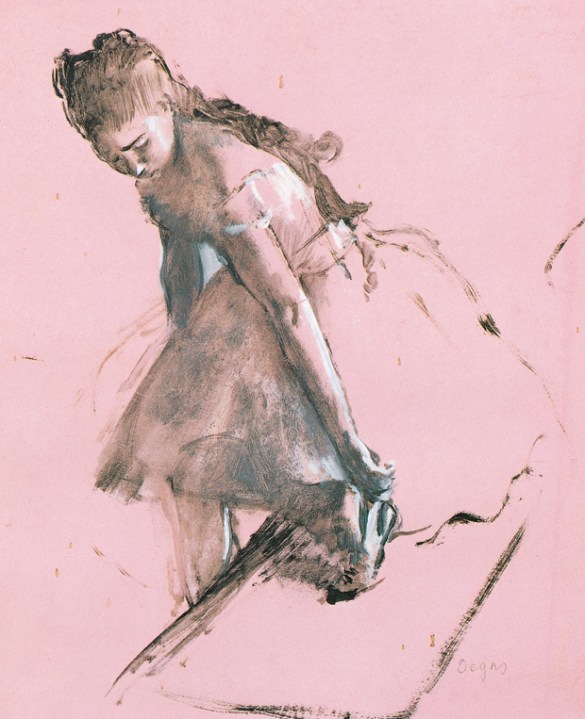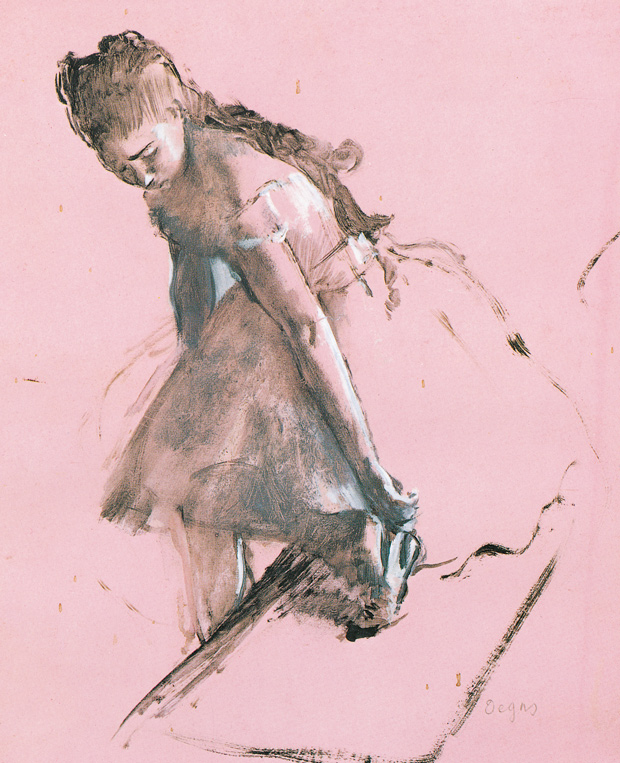Lucian Freud once said that ‘being able to draw well is the hardest thing — far harder than painting, as one can easily see from the fact that there are so few great draughtsmen compared to the number of great painters — Ingres, Degas, Van Gogh, Rembrandt, just a few.’ Christopher Lloyd’s new study of Degas’s drawings and pastels, with over 200 beautifully reproduced illustrations, demonstrates that Edgar Degas (1834–1917) deserves his place on that list. And more than that, it shows that for him there was no distinction between painting and drawing.
In his art these categories so blur together that it is hard to say whether certain pictures — pastels with tempera paint additions, for example — are one or the other. And everything he did was based on drawing, which was, Degas said, a way of ‘seeing form’ (or as David Hockney has put it, ‘learning to see’).
On Friday, 13 February 1874 Edmond de Goncourt paid a visit to Degas. He spent the whole day looking at the work of this ‘strange painter’, who had ‘fallen in love with modern life, and out of all the subjects in modern life has chosen washerwomen and ballet dancers’. Looking though this new book must be a little like visiting Degas’s studio that day.
Degas’s art can seem repetitive, because in a way it was. Do the same subject, he advised, over and over again: ten times, a hundred times. ‘I assure you,’ he informed George Moore, ‘no art was ever less spontaneous than mine.’ Consequently, there are flocks of ballet dancers in this selection. They obsessed the artist because the dance was a real-life laboratory for the study of a range of movement that had never been depicted before. But personally, though I understand why they so interested Degas, I can see enough of his dancers.
I prefer his other themes, not all of which were shown to Goncourt. Among these were horses and jockeys, women washing — not nudes so much as naked people, freshly seen — café entertainers and milliners. Of the last, deftly at work amid clusters of ornate headwear like huge tropical blooms, Lloyd aptly notes, ‘Hats for Degas are the urban equivalent of Monet’s waterlilies at Giverny.’
It seemed Degas liked subjects that were artificial and — horse-racing aside — indoor. In a characteristic half-humorous, half-serious remark, he advocated stern measures to discourage plein-air painting (as practised by his colleagues Monet, Sisley and Pissarro). ‘If I were the government I would have a special brigade of gendarmes to keep an eye on artists who paint landscapes from nature. Oh, I don’t mean to kill anyone; just a little dose of bird-shot now and then as a warning.’
His ambition, Degas once said, was to be ‘famous and unknown’. He worked in the centre of Paris but completely hidden, in a studio that Lloyd compares to ‘Prospero’s cell — or, less poetically, the cell of a forensic scientist’. His models seem to have been fond of their odd employer, though one complained that he scratched her legs while measuring them with dividers.

After the artist’s death, she published her recollections of the studio: ‘Although vast, it was gloomy, because the high north-facing windows which occupied a whole wall were almost obstructed by a linen curtain, falling very low; only a dim daylight filtered in.’ Everywhere was a clutter of ‘cupboards, numerous easels jumbled together, sculpture stands, tables, armchairs, stools’ and the bathtub in which so many nudes posed. The cleaner was under standing orders to dust nothing in this room, just to clear a path from the door.
The dim light and his aversion to painting outdoors were connected with Degas’s anxiety about his sight. After his visit to the artist’s studio, Goncourt mused in his Journal on his new acquaintance: ‘An original fellow, this Degas, sickly, neurotic and afraid of losing his sight; but for that reason extremely sensitive and receptive to the character of things.’ By that date Degas, aged only 40, was already experiencing serious problems with his eyes.
In 1870, during the Franco-Prussian War he was rejected for service in the National Guard on the grounds that he could not see a target through his right eye; around the same time his left eye was also affected, possibly by a disease of the cornea. One of his symptoms was photophobia, or sensitivity to light; another was a ‘light cloudiness’ in his vision that he complained of in 1877. These facts add poignancy to his report of a visit to an exhibition of Monet’s paintings: ‘I met Monet himself there, and I said to him, “Let me get out of here. Those reflections in the water hurt my eyes!” ’

These were the conditions under which Degas produced almost all his greatest work, struggling to pin down forms that were threatening to melt into mist. He never entirely lost his sight, but seems to have given up work after about 1912. Up to that point, perhaps because of his fading vision, the marks he made with charcoal and pastel grew ever bolder and more personal.
He worked to a considerable extent for his own satisfaction. The dealer Ambroise Vollard once protested when he squashed and recommenced modelling a wax sculpture of a dancer that had seemed already to be finished. ‘All you think of is what it’s worth,’ the artist retorted. ‘I wouldn’t take a bucket of gold for the pleasure I’ve had in destroying it and making it again!’
Degas would be a difficult subject for a biographer; beyond his art and his conversation — punctuated by acerbic bons mots — little is known, and maybe there was not much to discover. He never married, and it is unclear whether he ever had so much as a love affair. Everything important that happened to him occurred inside his studio. Consequently the concise, elegantly informative introductions to the chapters of this book more or less provide all the necessary information. Essentially, Degas spent a lifetime following the advice his idol Ingres gave him in his youth: ‘Draw lines, young man, and still more lines.’







Comments